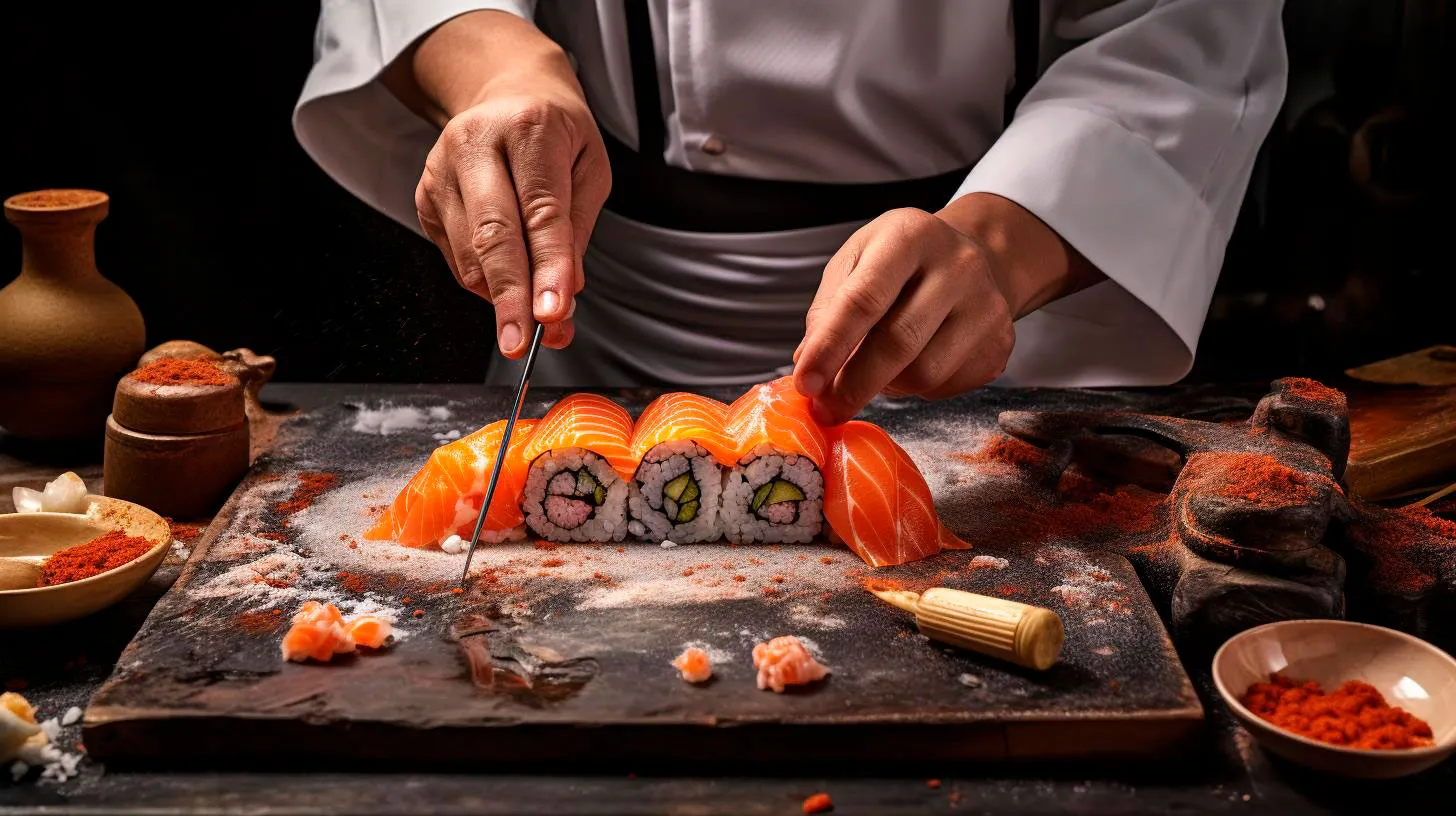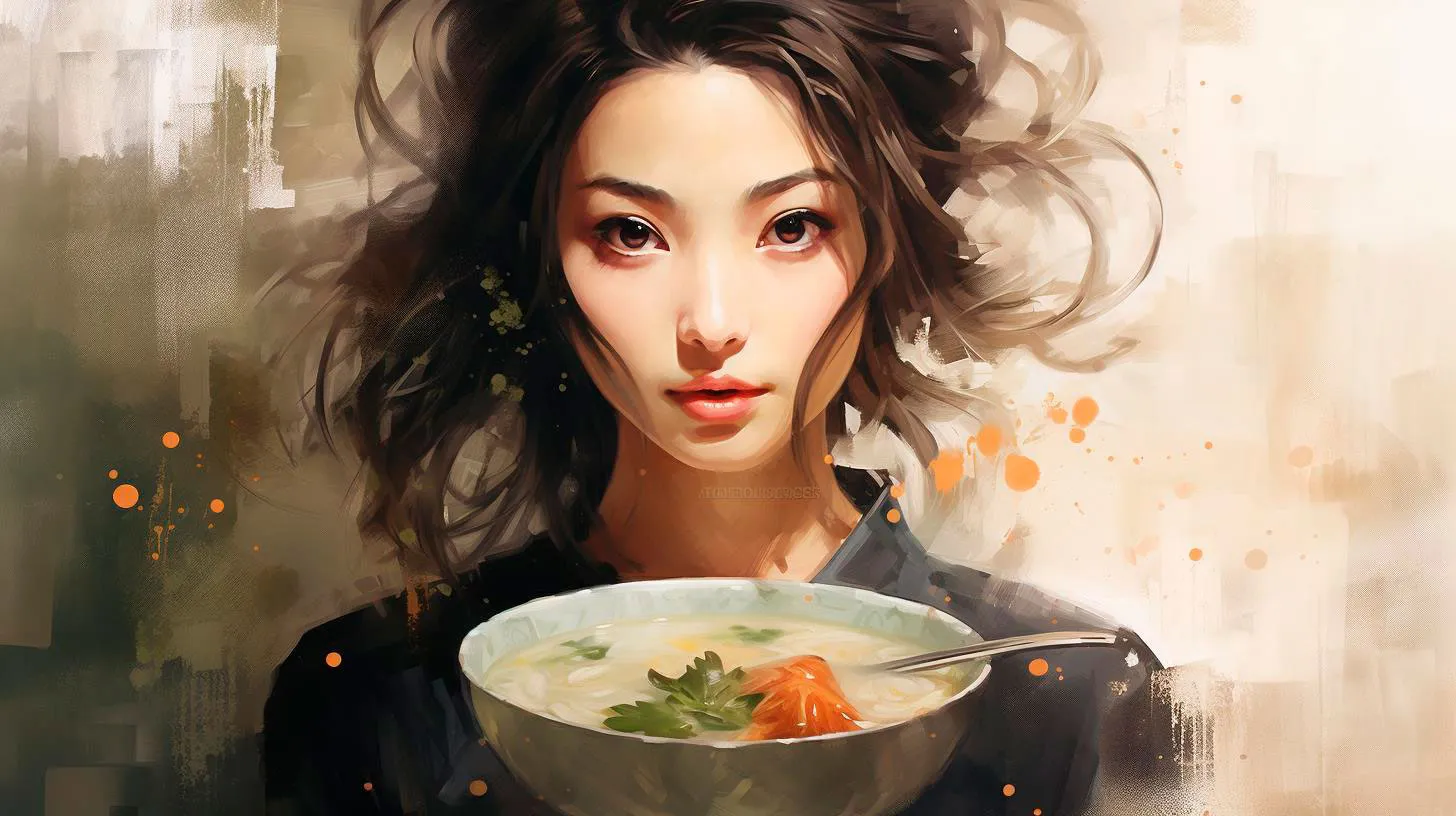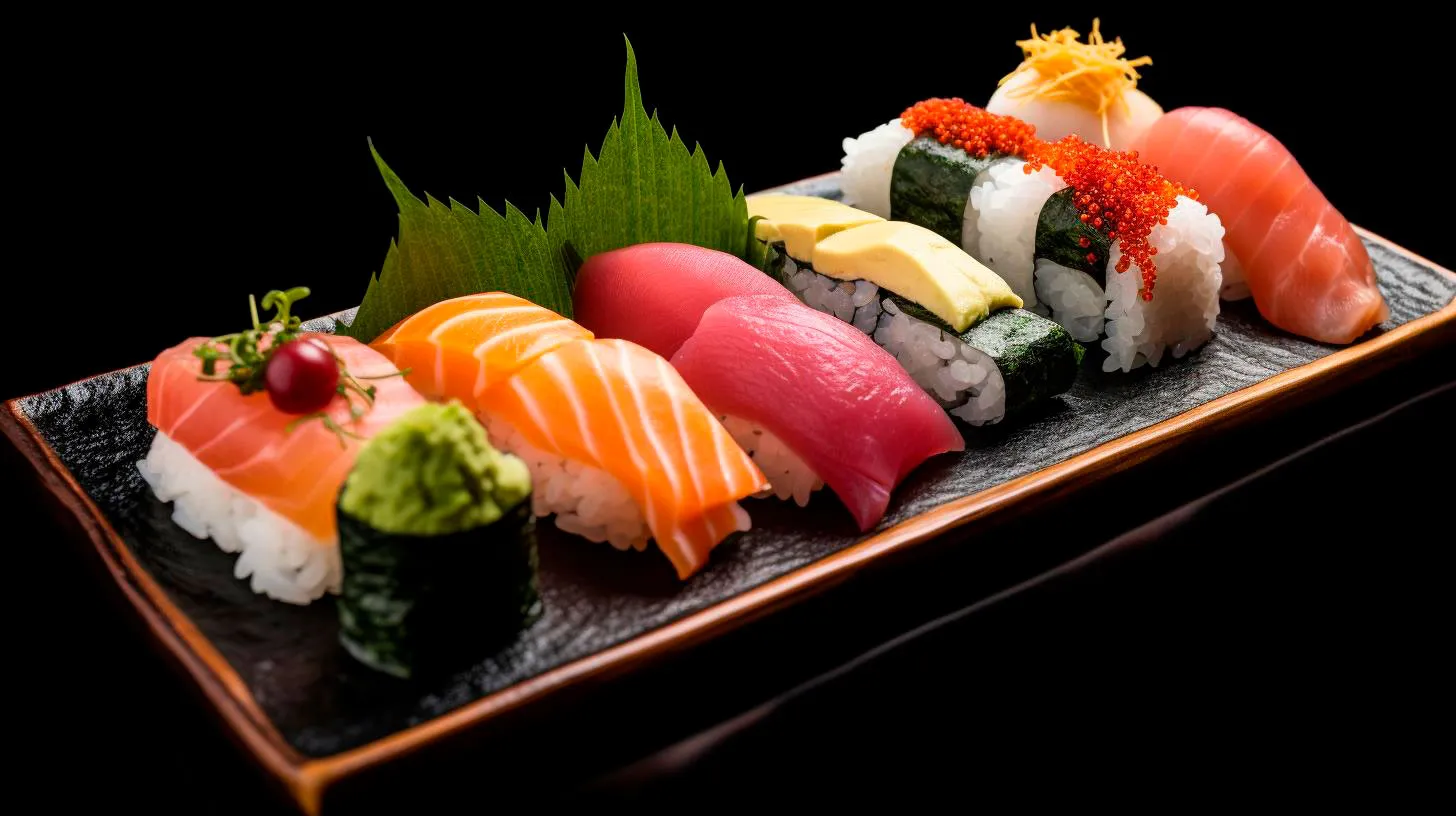Inside Culinary School Programs: Unveiling the Secrets of Sushi Artistry
It’s no wonder that many aspiring chefs aspire to master the art of sushi, leading them to seek out culinary school programs that offer specialized courses in sushi artistry.
Why Sushi Artistry Is Worth Exploring
Before diving into the details of culinary school programs, let’s take a moment to understand why studying sushi artistry is worth considering.
- Craftsmanship: Sushi-making is an intricate craft that demands exceptional knife skills, attention to detail, and knowledge of diverse ingredients. By opting for culinary school programs specializing in sushi artistry, aspiring chefs can hone their craftsmanship and become experts in this captivating form of culinary expression.
- Global Popularity: Sushi has transcended cultural boundaries and gained immense popularity worldwide. Whether you dream of opening your own sushi restaurant or want to work in prestigious establishments, mastering sushi artistry can open doors to exciting career opportunities in the global culinary industry.
- Health and Creativity: Sushi is not only visually appealing but also known for its health benefits. With an emphasis on fresh ingredients and balanced flavors, sushi offers a creative and nutritious approach to fine dining. Learning the art of sushi allows chefs to explore the fusion of flavors and experiment with innovative ingredient combinations.
Choosing the Right Culinary School Program for Sushi Artistry
Embarking on a culinary journey to become a sushi master requires careful selection of a culinary school program that caters to your specific goals and aspirations. Here are a few key factors to consider when choosing the right culinary school program for sushi artistry:
- Specialized Sushi Curricula: Look for programs that offer specialized courses solely focused on sushi-making techniques. These courses should cover everything from traditional sushi preparation methods to modern interpretations and innovative approaches to sushi artistry.
- Experienced Faculty: A knowledgeable and experienced faculty is essential for gaining insights into the art and science of sushi-making. Look for culinary schools that boast seasoned sushi chefs as instructors who can guide you through the intricacies of this ancient culinary practice.
- Hands-on Training: Sushi artistry relies heavily on practice and repetition. Opt for culinary school programs that provide extensive hands-on training, allowing you to develop the necessary skills and techniques required for sushi excellence.
- Industry Partnerships: Culinary schools with strong industry connections can provide invaluable opportunities for internships, externships, or mentorships with renowned sushi restaurants and chefs. These partnerships can serve as stepping stones to launch your sushi career.
- Networking Opportunities: Look for culinary schools that facilitate networking events, industry conferences, and alumni connections, as these can prove instrumental in building relationships and securing job placements in elite sushi establishments.
The Growing Demand for Sushi Artisans
According to the latest industry reports:
- The global sushi market is expected to reach $22.6 billion by 2027, growing at a CAGR of 4.8% from 2020 to 2027.
- In the United States alone, sushi restaurants rake in approximately $2 billion in annual sales.
- The demand for highly skilled sushi chefs is on the rise, with upscale restaurants and hotels actively seeking sushi artisans to cater to the growing consumer interest in authentic and innovative sushi experiences.
Key Takeaways
Culinary school programs specializing in sushi artistry offer aspiring chefs an incredible opportunity to delve into the captivating world of sushi-making. Key takeaways to keep in mind include:
- Developing craftsmanship and precision in sushi-making is essential for aspiring sushi artisans.
- Mastering sushi artistry can open doors to exciting career opportunities in the global culinary industry.
- Choosing the right culinary school program with specialized sushi curricula, experienced faculty, and hands-on training is crucial for success.
- Strong industry partnerships and networking opportunities can greatly enhance career prospects in the sushi industry.
- The growing demand for sushi artisans presents a favorable job market with numerous opportunities for skilled chefs.
By pursuing a culinary school program that focuses on sushi artistry, you can unlock the secrets of this ancient culinary craft, elevate your culinary skills, and embark on a rewarding career as a sushi master.
Unleashing Creativity: Exploring the Artistic Side of Sushi Making
Traditional Japanese cuisine has always embraced the importance of presentation. With sushi, this emphasis on aesthetics takes center stage. Sushi chefs use a variety of techniques to transform ordinary ingredients into visually stunning creations that are almost too beautiful to eat. Let’s dive into the world of sushi making and explore the artistic side that captivates both chefs and diners alike.
The Art of Plating
Plating is an essential aspect of sushi making that elevates the dining experience. Chefs meticulously arrange each ingredient to create balance and harmony on the plate. Beautifully sliced sashimi dishes are artfully arranged to showcase both colors and textures. The vibrant hues of fresh seafood and the gentle curves of perfectly formed rolls are a visual delight.
Key Takeaway: The art of plating sushi plays a crucial role in making the dining experience visually appealing, stimulating our senses before we even take our first bite.
The Makizushi: A Canvas for Creativity
One of the most versatile sushi styles is the Makizushi, or rolled sushi. The cylindrical shape of the roll provides chefs with a blank canvas to unleash their creativity. From intricate patterns to colorful fillings, the possibilities are endless. Chefs use various techniques like cross-cutting, slicing, and shaping to transform mundane ingredients into eye-catching works of art.
Key Takeaway: Makizushi allows sushi chefs to break free from traditional norms and experiment with unconventional flavors, textures, and presentations.
The Zen of Nigiri
Nigiri sushi, the hand-pressed style, represents the simplicity and elegance of sushi making. Each piece is carefully crafted by shaping a small mound of sushi rice and topping it with a slice of fish or seafood. The delicacy of this style lies in the perfection of the rice-to-fish ratio and the precise molding of each piece.
Key Takeaway: Nigiri sushi celebrates simplicity, highlighting the skill of the sushi chef in achieving a harmonious balance of flavors, textures, and shapes.
Embracing Seasonality and Freshness
A fundamental principle in sushi making is the emphasis on seasonality and freshness. Many traditional sushi chefs believe that the best sushi can only be created using the freshest ingredients available. This dedication to quality means that sushi menus often change with the seasons, allowing chefs to showcase the best flavors each time.
Key Takeaway: Sushi making embodies the concept of “farm to table,” promoting sustainable practices and a deeper connection to nature’s bounty.
Techniques: A Fusion of Tradition and Innovation
While traditional sushi making techniques are revered and passed down through generations, sushi chefs also embrace innovation to push the boundaries of creativity. Techniques like molecular gastronomy and fusion cooking have found their way into sushi making, adding unique twists and surprising elements to traditional dishes.
Key Takeaway: The fusion of tradition and innovation in sushi making allows chefs to captivate diners with new flavors and experiences while paying homage to the centuries-old art form.
Advancements in Sushi Artistry
Sushi artistry continues to evolve, driven by advancements in technology, changing customer preferences, and the influence of globalization. Here are a few notable advancements shaping the world of sushi making:
- Sushi Robots: These automated machines can precisely portion sushi rice and make evenly shaped rolls, allowing chefs to focus more on the creative aspects of sushi making.
- Artisanal Sushi: Some sushi chefs are embracing the artisanal movement, closely working with local suppliers and using traditional techniques to create exclusive, high-quality sushi experiences.
- Sushi Fusion: Influences from different culinary traditions have sparked a sushi fusion revolution, resulting in unique combinations and unexpected flavors.
- Social Media and Food Photography: The rise of social media has transformed sushi making into a visual feast, with chefs striving to create stunningly photogenic dishes that are shared worldwide.
In today’s fast-paced world, sushi making continues to captivate food enthusiasts around the globe. The artistic side of sushi making invites chefs to push boundaries and develop innovative techniques, resulting in a truly memorable dining experience. So, the next time you enjoy a plate of sushi, take a moment to appreciate not only the flavors but also the artistry that goes into creating these edible masterpieces.
Cultural Connections: Discovering the Rich Heritage of Sushi through Culinary Education
In this blog post, we delve into the fascinating history, cultural significance, and artistry of sushi. We also discuss how culinary education can be a gateway to understanding and appreciating this beloved cuisine.
The History and Evolution of Sushi
Sushi has a history that spans over a thousand years. Its roots can be traced back to ancient Japan, where it was initially a method of preserving fish by fermenting it with rice. Over time, sushi evolved into a cuisine that embraced fresh ingredients and delicate flavors. Today, sushi is not only a culinary delight but also an artistic expression of Japanese culture.
Key Takeaways:
- Sushi has a history of over a thousand years.
- It originated as a method of preserving fish.
- Modern sushi focuses on fresh ingredients and delicate flavors.
The Artistry of Sushi
Sushi is not just about taste; it is a visual masterpiece. Sushi chefs, also known as Itamae, consider their craft an art form. Every slice, every roll, and every placement of ingredients on the plate is done with precision and care. The artistry lies in the balance of colors, textures, and flavors. Sushi is not only a treat for the taste buds but also a feast for the eyes.
Key Takeaways:
- Sushi chefs approach their craft as an art form.
- Attention to detail and precision are key in sushi preparation.
- Sushi is a feast for both the taste buds and the eyes.
The Cultural Significance of Sushi
In Japan, sushi is deeply embedded in the country’s culture and traditions. It is more than just a meal; it is a symbol of hospitality, craftsmanship, and nature. Sushi represents harmony and balance, reflecting the values of the Japanese people. By understanding the cultural significance of sushi, we gain a deeper appreciation for the dish and its connection to Japan’s rich heritage.
Key Takeaways:
- Sushi embodies Japanese culture, tradition, and values.
- It represents harmony, balance, and craftsmanship.
- Sushi is deeply connected to Japan’s rich heritage.
Discovering Sushi through Culinary Education
Culinary education provides a platform for people to delve into the world of sushi and gain a deeper understanding of its history, artistry, and cultural significance. By enrolling in sushi-making classes or culinary programs that focus on sushi, enthusiasts can learn about the different types of sushi rolls, sushi etiquette, and the use of traditional ingredients.
Key Takeaways:
- Culinary education helps us explore sushi beyond just being a dish.
- Sushi-making classes offer insights into the art and techniques behind sushi preparation.
- Understanding sushi etiquette enhances the dining experience.
Advantages of Learning about Sushi through Culinary Education
1. In-depth Knowledge: Culinary education equips individuals with comprehensive knowledge about sushi, enabling them to appreciate its nuances and intricacies.
2. Cultural Appreciation: Learning about sushi through culinary education fosters cultural appreciation and sensitivity towards Japan and its traditions.
3. Personal Development: Mastering the art of sushi-making through culinary education enhances creativity, attention to detail, and problem-solving skills.
4. Culinary Career Opportunities: Culinary education focusing on sushi can open doors to exciting career opportunities in the culinary industry, such as sushi chef positions and restaurant management.
In Conclusion
Sushi is more than just a dish; it is a cultural symbol that carries centuries of tradition and artistry. Through culinary education, we can uncover the intricate details and gain a deeper appreciation for this beloved cuisine. Whether you are a sushi enthusiast or someone interested in Japanese culture, exploring sushi through educational avenues can be a truly enlightening and enjoyable experience.
From Knife Skills to Plating Techniques: Mastering the Art of Sushi
In this article, we will explore the foundations of sushi-making, from knife skills to plating techniques, so you can create stunning and delicious sushi creations that will impress both the eye and the palate.
The Importance of Knife Skills
A well-crafted sushi dish starts with proper knife skills. The delicate nature of sushi requires slicing fish and other ingredients with utmost precision to ensure a symmetrical and visually pleasing presentation. Here are some key knife skills every sushi enthusiast should master:
- Sharp knives: Investing in quality, razor-sharp knives is essential for clean and precise cuts. Dull knives can lead to uneven slices and diminish the overall presentation of your sushi.
- Slicing techniques: Understanding different slicing techniques, such as sashimi (thin slices), hira-zukuri (rectangular slices), and tataki (seared and thinly sliced), can bring variety and texture to your sushi creations.
- Consistent thickness: Achieving consistent thickness in your cuts is crucial to ensure even cooking and a visually appealing plate. Practice slicing ingredients with a steady hand and consistent pressure.
By mastering these knife skills, you can transform raw ingredients into stunning pieces of art that showcase the beauty of sushi.
The Art of Sushi Plating
Creating a visually captivating plate is just as important as the flavors in sushi. The art of plating involves carefully arranging sushi elements on the plate to create a harmonious balance of colors, textures, and shapes. Consider these techniques when plating your sushi creations:
- Color palette: Incorporate vibrant and contrasting colors, such as bright orange salmon, creamy white tuna, and deep green seaweed, to create a visually striking plate.
- Symmetry and balance: Aim for symmetrical arrangements and balanced placement of ingredients to create a visually pleasing composition.
- Garnishes and decorations: Elevate your plate with garnishes like edible flowers, microgreens, or decorative sauces. These artistic touches add a pop of color and enhance the overall presentation.
Remember, plating is not just about aesthetics; it also influences the dining experience and enhances the appreciation of flavors.
Key Takeaways: Mastering the Art of Sushi
Here are key takeaways to help you master the art of sushi:
- Invest in high-quality, sharp knives to ensure precise cuts.
- Practice various knife techniques, such as sashimi and hira-zukuri, to add variety to your sushi creations.
- Achieve consistent thickness in your cuts for even cooking and an appealing presentation.
- Consider the color palette of your ingredients when plating sushi for a visually striking result.
- Create a symmetrical and balanced arrangement of ingredients to enhance the overall composition.
- Use garnishes and decorative elements to elevate the visual appeal of your sushi plate.
By mastering these techniques, you can create sushi dishes that not only taste exquisite but also captivate the eyes. The art of sushi-making is a journey that requires practice, patience, and a passion for culinary creativity. So, pick up your knives and start honing your skills – and who knows, maybe you’ll become a sushi master in no time!


